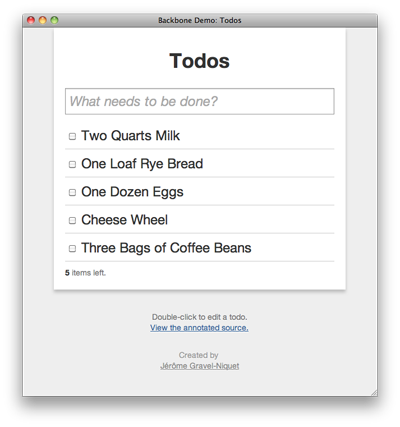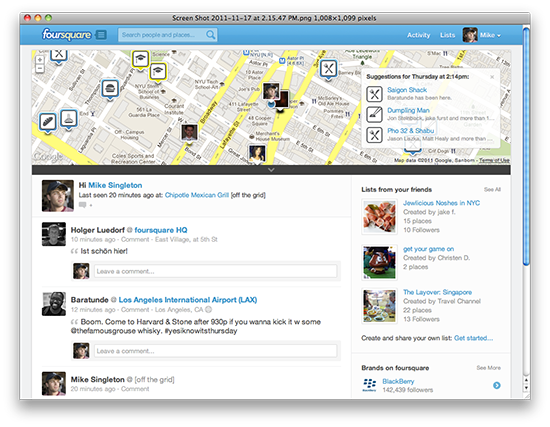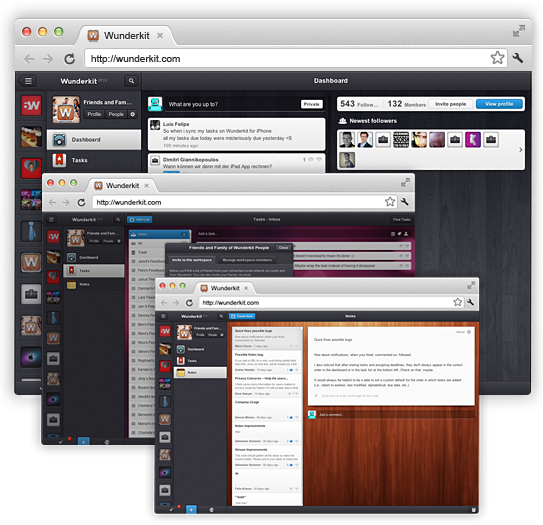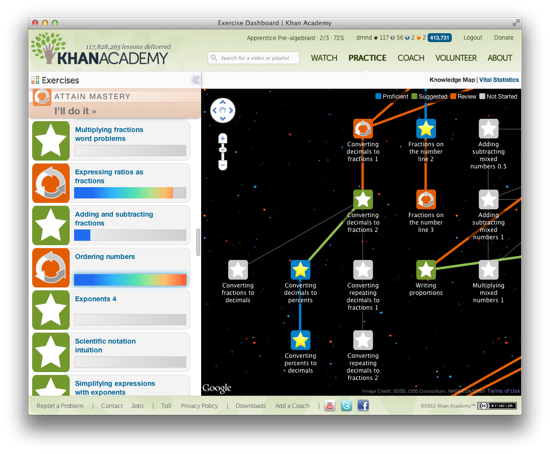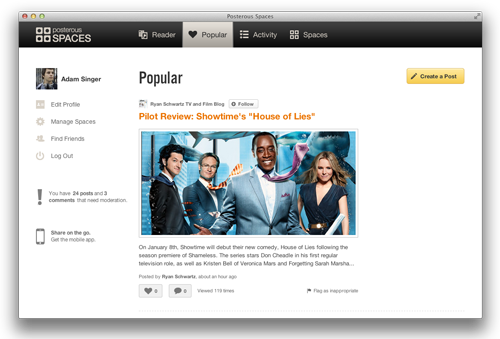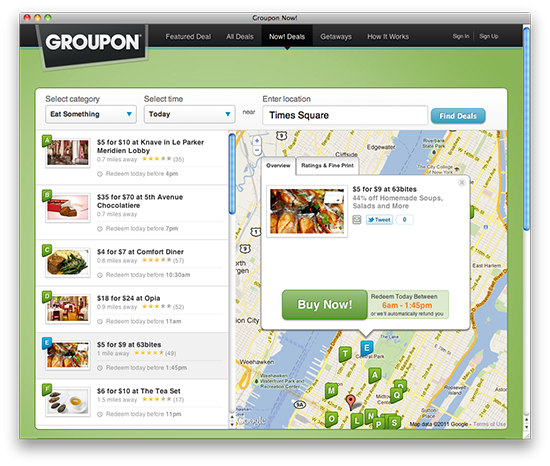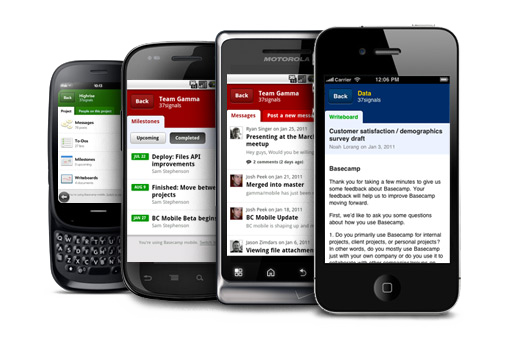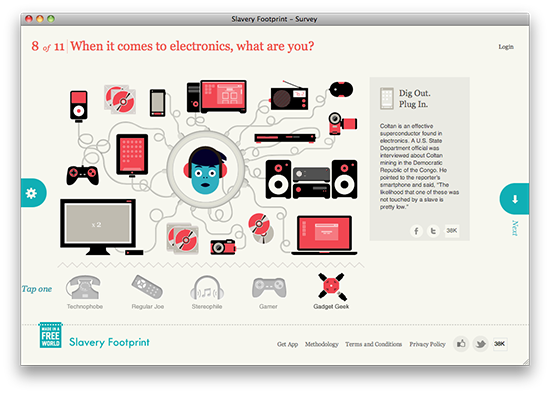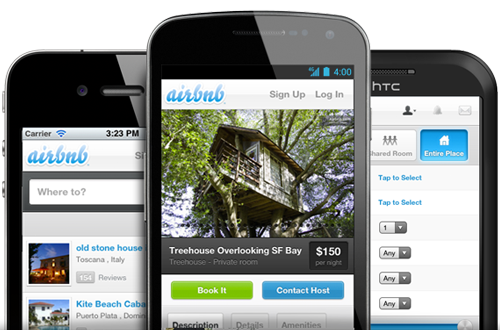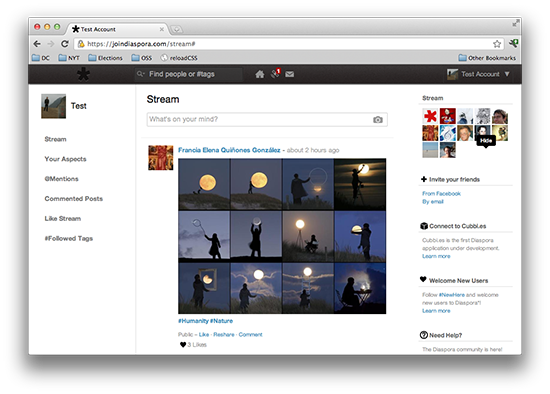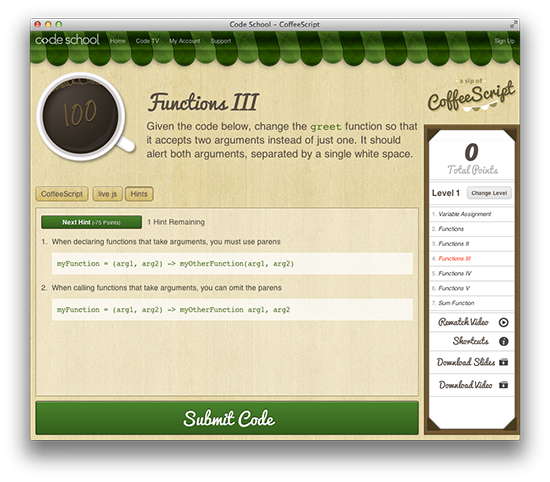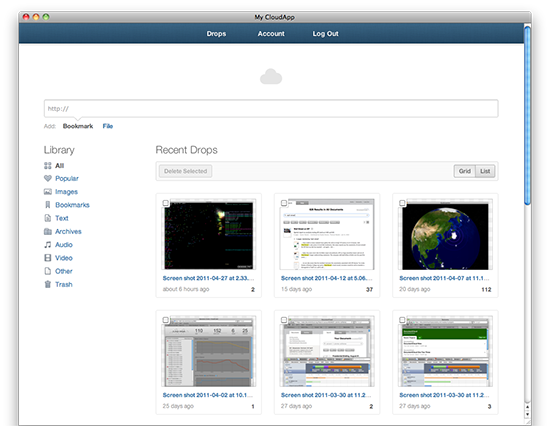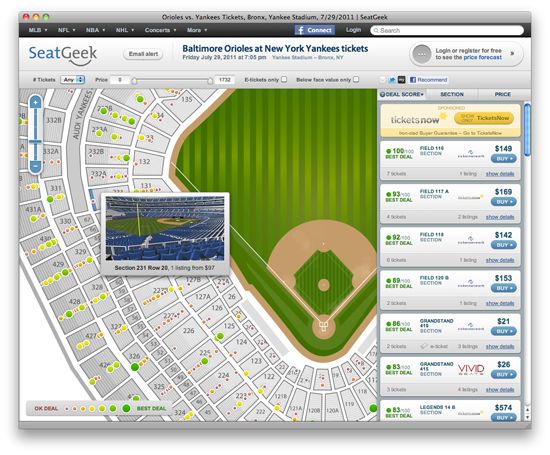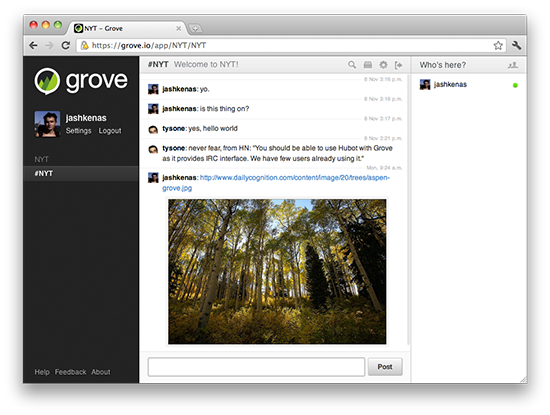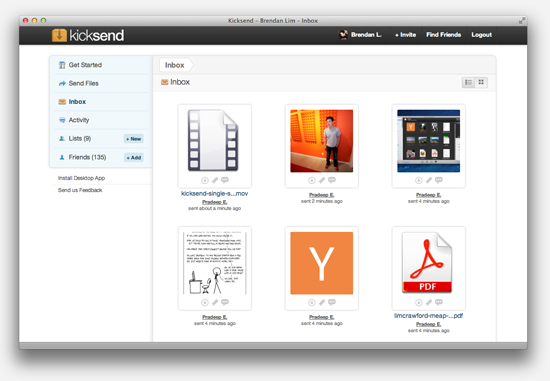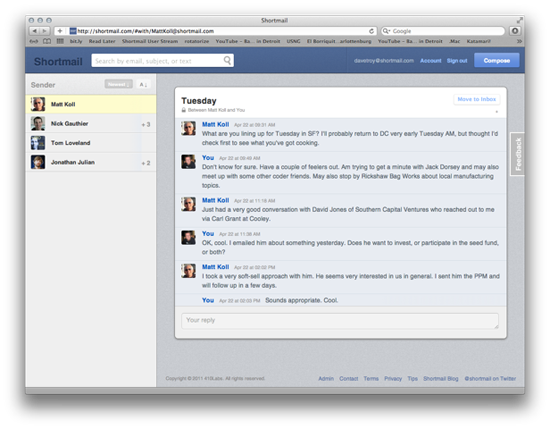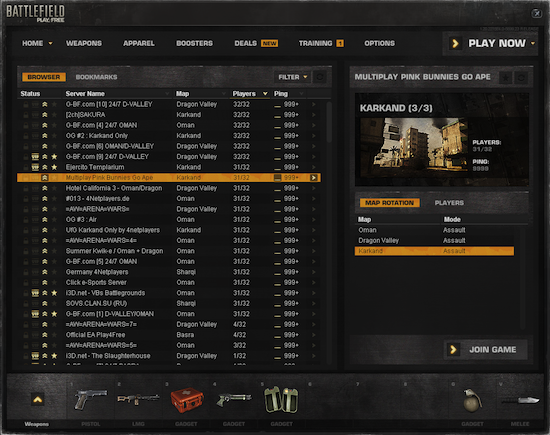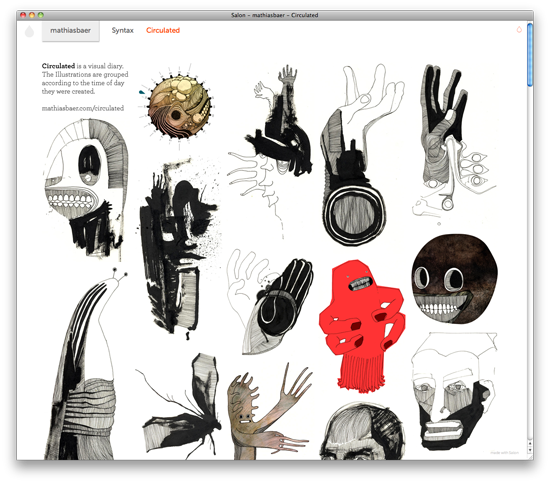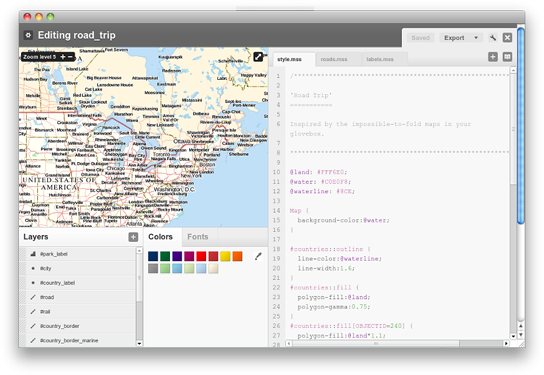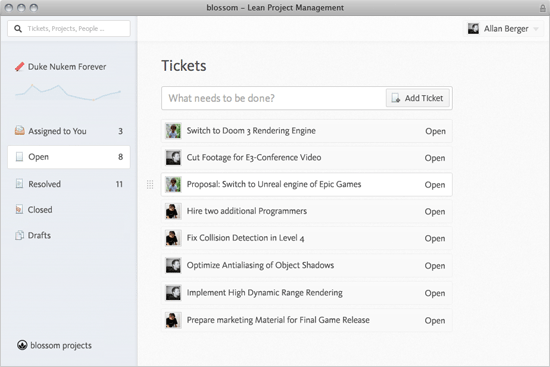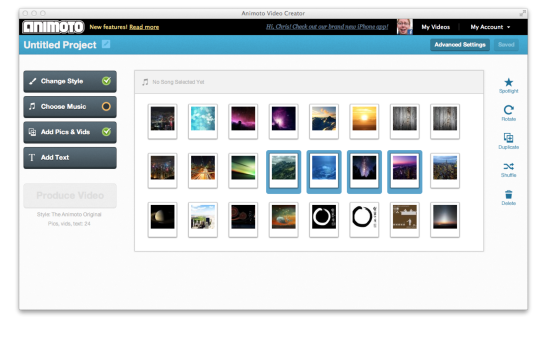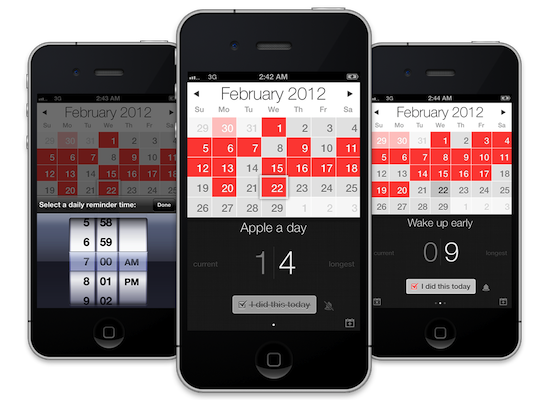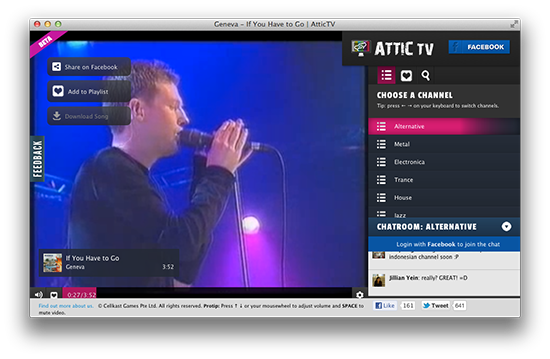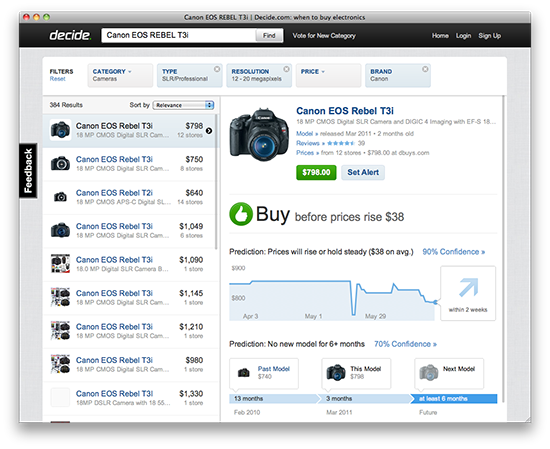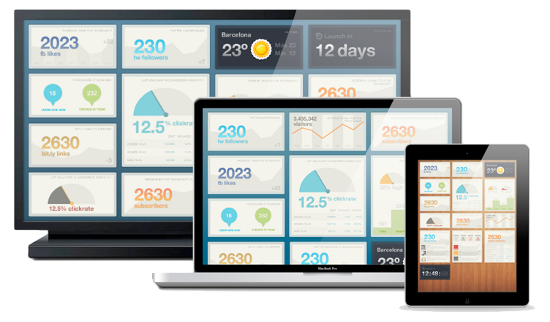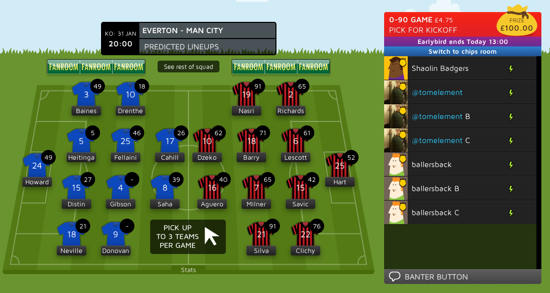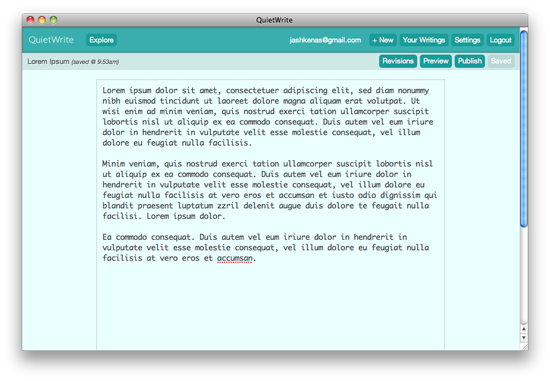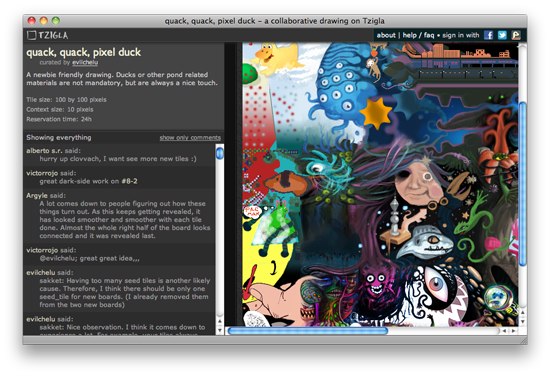
Backbone.js gives structure to web applications by providing models with key-value binding and custom events, collections with a rich API of enumerable functions, views with declarative event handling, and connects it all to your existing API over a RESTful JSON interface.
The project is hosted on GitHub, and the annotated source code is available, as well as an online test suite, an example application, a list of tutorials and a long list of real-world projects that use Backbone. Backbone is available for use under the MIT software license.
You can report bugs and discuss features on the GitHub issues page, on Freenode IRC in the #documentcloud channel, post questions to the Google Group, add pages to the wiki or send tweets to @documentcloud.
Backbone is an open-source component of DocumentCloud.
Downloads & Dependencies (Right-click, and use "Save As")
| Development Version (0.9.2) | 52kb, Full source, lots of comments |
| Production Version (0.9.2) | 5.6kb, Packed and gzipped |
Backbone's only hard dependency is Underscore.js ( > 1.3.1). For RESTful persistence, history support via Backbone.Router and DOM manipulation with Backbone.View, include json2.js, and either jQuery ( > 1.4.2) or Zepto.
Introduction
When working on a web application that involves a lot of JavaScript, one of the first things you learn is to stop tying your data to the DOM. It's all too easy to create JavaScript applications that end up as tangled piles of jQuery selectors and callbacks, all trying frantically to keep data in sync between the HTML UI, your JavaScript logic, and the database on your server. For rich client-side applications, a more structured approach is often helpful.
With Backbone, you represent your data as Models, which can be created, validated, destroyed, and saved to the server. Whenever a UI action causes an attribute of a model to change, the model triggers a "change" event; all the Views that display the model's state can be notified of the change, so that they are able to respond accordingly, re-rendering themselves with the new information. In a finished Backbone app, you don't have to write the glue code that looks into the DOM to find an element with a specific id, and update the HTML manually — when the model changes, the views simply update themselves.
If you're new here, and aren't yet quite sure what Backbone is for, start by browsing the list of Backbone-based projects.
Many of the examples that follow are runnable. Click the play button to execute them.
Upgrading to 0.9
Backbone's 0.9 series should be considered as a release candidate for an upcoming 1.0. Some APIs have changed, and while there is a change log available, and many new features to take advantage of, there are a few specific changes where you'll need to take care:
- If you've ever manually set this.el in a Backbone View to be a particular DOM element, you'll want to use setElement instead.
- Creating and destroying models is now optimistic. Pass {wait: true} if you need the previous behavior of waiting for the server to acknowledge success. You can now also pass {wait: true} to save calls.
- If you have been writing a fair amount of $(view.el), there's now a cached reference for that jQuery object: $el.
- If you're upgrading, make sure you also upgrade your version of Underscore.js to the latest — 1.3.1 or greater.
- model.set will no longer trigger change events when setting a value with {silent: true} then setting it back to its original value. Similarly, after changing an attribute silently, that change:attribute event will fire during the next change.
- Since view.$(selector) is now equivalent to view.$el.find(selector) rather than $(selector, view.el) it can no longer be used when selector is an HTML string or DOM element.
Backbone.Events
Events is a module that can be mixed in to any object, giving the object the ability to bind and trigger custom named events. Events do not have to be declared before they are bound, and may take passed arguments. For example:
var object = {};
_.extend(object, Backbone.Events);
object.on("alert", function(msg) {
alert("Triggered " + msg);
});
object.trigger("alert", "an event");
For example, to make a handy event dispatcher that can coordinate events among different areas of your application: var dispatcher = _.clone(Backbone.Events)
onobject.on(event, callback, [context])Alias: bind
Bind a callback function to an object. The callback will be invoked
whenever the event is fired.
If you have a large number of different events on a page, the convention is to use colons to
namespace them: "poll:start", or "change:selection".
The event string may also be a space-delimited list of several events...
book.on("change:title change:author", ...);
To supply a context value for this when the callback is invoked, pass the optional third argument: model.on('change', this.render, this)
Callbacks bound to the special "all" event will be triggered when any event occurs, and are passed the name of the event as the first argument. For example, to proxy all events from one object to another:
proxy.on("all", function(eventName) {
object.trigger(eventName);
});
offobject.off([event], [callback], [context])Alias: unbind
Remove a previously-bound callback function from an object. If no
context is specified, all of the versions of the callback with
different contexts will be removed. If no
callback is specified, all callbacks for the event will be
removed. If no event is specified, all event callbacks on the object
will be removed.
// Removes just the `onChange` callback.
object.off("change", onChange);
// Removes all "change" callbacks.
object.off("change");
// Removes the `onChange` callback for all events.
object.off(null, onChange);
// Removes all callbacks for `context` for all events.
object.off(null, null, context);
// Removes all callbacks on `object`.
object.off();
triggerobject.trigger(event, [*args])
Trigger callbacks for the given event, or space-delimited list of events.
Subsequent arguments to trigger will be passed along to the
event callbacks.
Backbone.Model
Models are the heart of any JavaScript application, containing the interactive data as well as a large part of the logic surrounding it: conversions, validations, computed properties, and access control. You extend Backbone.Model with your domain-specific methods, and Model provides a basic set of functionality for managing changes.
The following is a contrived example, but it demonstrates defining a model with a custom method, setting an attribute, and firing an event keyed to changes in that specific attribute. After running this code once, sidebar will be available in your browser's console, so you can play around with it.
var Sidebar = Backbone.Model.extend({
promptColor: function() {
var cssColor = prompt("Please enter a CSS color:");
this.set({color: cssColor});
}
});
window.sidebar = new Sidebar;
sidebar.on('change:color', function(model, color) {
$('#sidebar').css({background: color});
});
sidebar.set({color: 'white'});
sidebar.promptColor();
extendBackbone.Model.extend(properties, [classProperties])
To create a Model class of your own, you extend Backbone.Model
and provide instance properties, as well as optional
classProperties to be attached directly to the constructor function.
extend correctly sets up the prototype chain, so subclasses created with extend can be further extended and subclassed as far as you like.
var Note = Backbone.Model.extend({
initialize: function() { ... },
author: function() { ... },
coordinates: function() { ... },
allowedToEdit: function(account) {
return true;
}
});
var PrivateNote = Note.extend({
allowedToEdit: function(account) {
return account.owns(this);
}
});
Brief aside on super: JavaScript does not provide a simple way to call super — the function of the same name defined higher on the prototype chain. If you override a core function like set, or save, and you want to invoke the parent object's implementation, you'll have to explicitly call it, along these lines:
var Note = Backbone.Model.extend({
set: function(attributes, options) {
Backbone.Model.prototype.set.call(this, attributes, options);
...
}
});
constructor / initializenew Model([attributes])
When creating an instance of a model, you can pass in the initial values
of the attributes, which will be set on the
model. If you define an initialize function, it will be invoked when
the model is created.
new Book({
title: "One Thousand and One Nights",
author: "Scheherazade"
});
In rare cases, if you're looking to get fancy, you may want to override constructor, which allows you to replace the actual constructor function for your model.
getmodel.get(attribute)
Get the current value of an attribute from the model. For example:
note.get("title")
setmodel.set(attributes, [options])
Set a hash of attributes (one or many) on the model. If any of the attributes
change the models state, a "change" event will be triggered, unless
{silent: true} is passed as an option. Change events for specific
attributes are also triggered, and you can bind to those as well, for example:
change:title, and change:content. You may also pass
individual keys and values.
note.set({title: "March 20", content: "In his eyes she eclipses..."});
book.set("title", "A Scandal in Bohemia");
If the model has a validate method, it will be validated before the attributes are set, no changes will occur if the validation fails, and set will return false. Otherwise, set returns a reference to the model. You may also pass an error callback in the options, which will be invoked instead of triggering an "error" event, should validation fail. If {silent: true} is passed as an option, the validation is deferred until the next change.
escapemodel.escape(attribute)
Similar to get, but returns the HTML-escaped version
of a model's attribute. If you're interpolating data from the model into
HTML, using escape to retrieve attributes will prevent
XSS attacks.
var hacker = new Backbone.Model({
name: "<script>alert('xss')</script>"
});
alert(hacker.escape('name'));
hasmodel.has(attribute)
Returns true if the attribute is set to a non-null or non-undefined
value.
if (note.has("title")) {
...
}
unsetmodel.unset(attribute, [options])
Remove an attribute by deleting it from the internal attributes hash.
Fires a "change" event unless silent is passed as an option.
clearmodel.clear([options])
Removes all attributes from the model. Fires a "change" event unless
silent is passed as an option.
idmodel.id
A special property of models, the id is an arbitrary string
(integer id or UUID). If you set the id in the
attributes hash, it will be copied onto the model as a direct property.
Models can be retrieved by id from collections, and the id is used to generate
model URLs by default.
idAttributemodel.idAttribute
A model's unique identifier is stored under the id attribute.
If you're directly communicating with a backend (CouchDB, MongoDB) that uses
a different unique key, you may set a Model's idAttribute to
transparently map from that key to id.
var Meal = Backbone.Model.extend({
idAttribute: "_id"
});
var cake = new Meal({ _id: 1, name: "Cake" });
alert("Cake id: " + cake.id);
cidmodel.cid
A special property of models, the cid or client id is a unique identifier
automatically assigned to all models when they're first created. Client ids
are handy when the model has not yet been saved to the server, and does not
yet have its eventual true id, but already needs to be visible in the UI.
Client ids take the form: c1, c2, c3 ...
attributesmodel.attributes
The attributes property is the internal hash containing the model's
state. Please use set to update the attributes instead of modifying
them directly. If you'd like to retrieve and munge a copy of the model's
attributes, use toJSON instead.
changedmodel.changed
The changed property is the internal hash containing all the attributes
that have changed since the last "change" event was triggered.
Please do not update changed directly. Its state is maintained internally
by set and change.
A copy of changed can be acquired from
changedAttributes.
defaultsmodel.defaults or model.defaults()
The defaults hash (or function) can be used to specify the default
attributes for your model. When creating an instance of the model,
any unspecified attributes will be set to their default value.
var Meal = Backbone.Model.extend({
defaults: {
"appetizer": "caesar salad",
"entree": "ravioli",
"dessert": "cheesecake"
}
});
alert("Dessert will be " + (new Meal).get('dessert'));
Remember that in JavaScript, objects are passed by reference, so if you include an object as a default value, it will be shared among all instances.
toJSONmodel.toJSON()
Return a copy of the model's attributes for JSON stringification.
This can be used for persistence, serialization, or for augmentation before
being handed off to a view. The name of this method is a bit confusing, as
it doesn't actually return a JSON string — but I'm afraid that it's
the way that the JavaScript API for JSON.stringify works.
var artist = new Backbone.Model({
firstName: "Wassily",
lastName: "Kandinsky"
});
artist.set({birthday: "December 16, 1866"});
alert(JSON.stringify(artist));
fetchmodel.fetch([options])
Resets the model's state from the server by delegating to
Backbone.sync. Returns a
jqXHR.
Useful if the model has never
been populated with data, or if you'd like to ensure that you have the
latest server state. A "change" event will be triggered if the
server's state differs from the current attributes. Accepts
success and error callbacks in the options hash, which
are passed (model, response) as arguments.
// Poll every 10 seconds to keep the channel model up-to-date.
setInterval(function() {
channel.fetch();
}, 10000);
savemodel.save([attributes], [options])
Save a model to your database (or alternative persistence layer),
by delegating to Backbone.sync. Returns a
jqXHR if
validation is successful and false otherwise. The attributes
hash (as in set) should contain the attributes
you'd like to change — keys that aren't mentioned won't be altered — but,
a complete representation of the resource will be sent to the server.
As with set, you may pass individual keys and values instead of a hash.
If the model has a validate
method, and validation fails, the model will not be saved. If the model
isNew, the save will be a "create"
(HTTP POST), if the model already
exists on the server, the save will be an "update" (HTTP PUT).
Calling save with new attributes will cause a "change" event immediately, and a "sync" event after the server has acknowledged the successful change. Pass {wait: true} if you'd like to wait for the server before setting the new attributes on the model.
In the following example, notice how our overridden version of Backbone.sync receives a "create" request the first time the model is saved and an "update" request the second time.
Backbone.sync = function(method, model) {
alert(method + ": " + JSON.stringify(model));
model.id = 1;
};
var book = new Backbone.Model({
title: "The Rough Riders",
author: "Theodore Roosevelt"
});
book.save();
book.save({author: "Teddy"});
save accepts success and error callbacks in the options hash, which are passed (model, response) as arguments. The error callback will also be invoked if the model has a validate method, and validation fails. If a server-side validation fails, return a non-200 HTTP response code, along with an error response in text or JSON.
book.save("author", "F.D.R.", {error: function(){ ... }});
destroymodel.destroy([options])
Destroys the model on the server by delegating an HTTP DELETE
request to Backbone.sync. Returns a
jqXHR object, or
false if the model isNew. Accepts
success and error callbacks in the options hash.
Triggers a "destroy" event on the model, which will bubble up
through any collections that contain it, and a "sync" event, after
the server has successfully acknowledged the model's deletion. Pass
{wait: true} if you'd like to wait for the server to respond
before removing the model from the collection.
book.destroy({success: function(model, response) {
...
}});
validatemodel.validate(attributes)
This method is left undefined, and you're encouraged to override it with
your custom validation logic, if you have any that can be performed
in JavaScript. validate is called before set and
save, and is passed the model attributes updated with the values
from set or save.
If the attributes are valid, don't return anything from validate;
if they are invalid, return an error of your choosing. It
can be as simple as a string error message to be displayed, or a complete
error object that describes the error programmatically. If validate
returns an error, set and save will not continue, and the
model attributes will not be modified.
Failed validations trigger an "error" event.
var Chapter = Backbone.Model.extend({
validate: function(attrs) {
if (attrs.end < attrs.start) {
return "can't end before it starts";
}
}
});
var one = new Chapter({
title : "Chapter One: The Beginning"
});
one.on("error", function(model, error) {
alert(model.get("title") + " " + error);
});
one.set({
start: 15,
end: 10
});
"error" events are useful for providing coarse-grained error messages at the model or collection level, but if you have a specific view that can better handle the error, you may override and suppress the event by passing an error callback directly:
account.set({access: "unlimited"}, {
error: function(model, error) {
alert(error);
}
});
isValidmodel.isValid()
Models may enter an invalid state if you make changes to them silently
... useful when dealing with form input. Call model.isValid()
to check if the model is currently in a valid state, according to your
validate function.
urlmodel.url()
Returns the relative URL where the model's resource would be located on
the server. If your models are located somewhere else, override this method
with the correct logic. Generates URLs of the form: "/[collection.url]/[id]",
falling back to "/[urlRoot]/id" if the model is not part of a collection.
Delegates to Collection#url to generate the URL, so make sure that you have it defined, or a urlRoot property, if all models of this class share a common root URL. A model with an id of 101, stored in a Backbone.Collection with a url of "/documents/7/notes", would have this URL: "/documents/7/notes/101"
urlRootmodel.urlRoot or model.urlRoot()
Specify a urlRoot if you're using a model outside of a collection,
to enable the default url function to generate
URLs based on the model id. "/[urlRoot]/id"
Note that urlRoot may also be defined as a function.
var Book = Backbone.Model.extend({urlRoot : '/books'});
var solaris = new Book({id: "1083-lem-solaris"});
alert(solaris.url());
parsemodel.parse(response)
parse is called whenever a model's data is returned by the
server, in fetch, and save.
The function is passed the raw response object, and should return
the attributes hash to be set on the model. The
default implementation is a no-op, simply passing through the JSON response.
Override this if you need to work with a preexisting API, or better namespace
your responses.
If you're working with a Rails backend, you'll notice that Rails' default to_json implementation includes a model's attributes under a namespace. To disable this behavior for seamless Backbone integration, set:
ActiveRecord::Base.include_root_in_json = false
clonemodel.clone()
Returns a new instance of the model with identical attributes.
isNewmodel.isNew()
Has this model been saved to the server yet? If the model does not yet have
an id, it is considered to be new.
changemodel.change()
Manually trigger the "change" event and a "change:attribute"
event for each attribute that has changed. If you've been passing
{silent: true} to the set function in order to
aggregate rapid changes to a model, you'll want to call model.change()
when you're all finished.
hasChangedmodel.hasChanged([attribute])
Has the model changed since the last "change" event? If an attribute
is passed, returns true if that specific attribute has changed.
Note that this method, and the following change-related ones, are only useful during the course of a "change" event.
book.on("change", function() {
if (book.hasChanged("title")) {
...
}
});
changedAttributesmodel.changedAttributes([attributes])
Retrieve a hash of only the model's attributes that have changed. Optionally,
an external attributes hash can be passed in, returning
the attributes in that hash which differ from the model. This can be used
to figure out which portions of a view should be updated, or what calls
need to be made to sync the changes to the server.
previousmodel.previous(attribute)
During a "change" event, this method can be used to get the
previous value of a changed attribute.
var bill = new Backbone.Model({
name: "Bill Smith"
});
bill.on("change:name", function(model, name) {
alert("Changed name from " + bill.previous("name") + " to " + name);
});
bill.set({name : "Bill Jones"});
previousAttributesmodel.previousAttributes()
Return a copy of the model's previous attributes. Useful for getting a
diff between versions of a model, or getting back to a valid state after
an error occurs.
Backbone.Collection
Collections are ordered sets of models. You can bind "change" events to be notified when any model in the collection has been modified, listen for "add" and "remove" events, fetch the collection from the server, and use a full suite of Underscore.js methods.
Any event that is triggered on a model in a collection will also be triggered on the collection directly, for convenience. This allows you to listen for changes to specific attributes in any model in a collection, for example: Documents.on("change:selected", ...)
extendBackbone.Collection.extend(properties, [classProperties])
To create a Collection class of your own, extend Backbone.Collection,
providing instance properties, as well as optional classProperties to be attached
directly to the collection's constructor function.
modelcollection.model
Override this property to specify the model class that the collection
contains. If defined, you can pass raw attributes objects (and arrays) to
add, create,
and reset, and the attributes will be
converted into a model of the proper type.
var Library = Backbone.Collection.extend({
model: Book
});
constructor / initializenew Collection([models], [options])
When creating a Collection, you may choose to pass in the initial array of models.
The collection's comparator function
may be included as an option. If you define an initialize function, it will be
invoked when the collection is created.
var tabs = new TabSet([tab1, tab2, tab3]);
modelscollection.models
Raw access to the JavaScript array of models inside of the collection. Usually you'll
want to use get, at, or the Underscore methods
to access model objects, but occasionally a direct reference to the array
is desired.
toJSONcollection.toJSON()
Return an array containing the attributes hash of each model in the
collection. This can be used to serialize and persist the
collection as a whole. The name of this method is a bit confusing, because
it conforms to
JavaScript's JSON API.
var collection = new Backbone.Collection([
{name: "Tim", age: 5},
{name: "Ida", age: 26},
{name: "Rob", age: 55}
]);
alert(JSON.stringify(collection));
Underscore Methods (28)
Backbone proxies to Underscore.js to provide 28 iteration functions
on Backbone.Collection. They aren't all documented here, but
you can take a look at the Underscore documentation for the full details…
- forEach (each)
- map
- reduce (foldl, inject)
- reduceRight (foldr)
- find (detect)
- filter (select)
- reject
- every (all)
- some (any)
- include
- invoke
- max
- min
- sortBy
- groupBy
- sortedIndex
- shuffle
- toArray
- size
- first
- initial
- rest
- last
- without
- indexOf
- lastIndexOf
- isEmpty
- chain
Books.each(function(book) {
book.publish();
});
var titles = Books.map(function(book) {
return book.get("title");
});
var publishedBooks = Books.filter(function(book) {
return book.get("published") === true;
});
var alphabetical = Books.sortBy(function(book) {
return book.author.get("name").toLowerCase();
});
addcollection.add(models, [options])
Add a model (or an array of models) to the collection. Fires an "add"
event, which you can pass {silent: true} to suppress. If a
model property is defined, you may also pass
raw attributes objects, and have them be vivified as instances of the model.
Pass {at: index} to splice the model into the collection at the
specified index. Likewise, if you're a callback listening to a
collection's "add" event, options.index will tell you the
index at which the model is being added to the collection.
var ships = new Backbone.Collection;
ships.on("add", function(ship) {
alert("Ahoy " + ship.get("name") + "!");
});
ships.add([
{name: "Flying Dutchman"},
{name: "Black Pearl"}
]);
removecollection.remove(models, [options])
Remove a model (or an array of models) from the collection. Fires a
"remove" event, which you can use silent
to suppress. If you're a callback listening to the "remove" event,
the index at which the model is being removed from the collection is available
as options.index.
getcollection.get(id)
Get a model from a collection, specified by id.
var book = Library.get(110);
getByCidcollection.getByCid(cid)
Get a model from a collection, specified by client id. The client id
is the .cid property of the model, automatically assigned whenever
a model is created. Useful for models which have not yet been saved to
the server, and do not yet have true ids.
atcollection.at(index)
Get a model from a collection, specified by index. Useful if your collection
is sorted, and if your collection isn't sorted, at will still
retrieve models in insertion order.
pushcollection.push(model, [options])
Add a model at the end of a collection. Takes the same options as
add.
popcollection.pop([options])
Remove and return the last model from a collection. Takes the same options as
remove.
unshiftcollection.unshift(model, [options])
Add a model at the beginning of a collection. Takes the same options as
add.
shiftcollection.shift([options])
Remove and return the first model from a collection. Takes the same options as
remove.
lengthcollection.length
Like an array, a Collection maintains a length property, counting
the number of models it contains.
comparatorcollection.comparator
By default there is no comparator function on a collection.
If you define a comparator, it will be used to maintain
the collection in sorted order. This means that as models are added,
they are inserted at the correct index in collection.models.
Comparator function can be defined as either a
sortBy
(pass a function that takes a single argument),
or as a
sort
(pass a comparator function that expects two arguments).
"sortBy" comparator functions take a model and return a numeric or string value by which the model should be ordered relative to others. "sort" comparator functions take two models, and return -1 if the first model should come before the second, 0 if they are of the same rank and 1 if the first model should come after.
Note how even though all of the chapters in this example are added backwards, they come out in the proper order:
var Chapter = Backbone.Model;
var chapters = new Backbone.Collection;
chapters.comparator = function(chapter) {
return chapter.get("page");
};
chapters.add(new Chapter({page: 9, title: "The End"}));
chapters.add(new Chapter({page: 5, title: "The Middle"}));
chapters.add(new Chapter({page: 1, title: "The Beginning"}));
alert(chapters.pluck('title'));
Collections with comparator functions will not automatically re-sort if you later change model attributes, so you may wish to call sort after changing model attributes that would affect the order.
sortcollection.sort([options])
Force a collection to re-sort itself. You don't need to call this under
normal circumstances, as a collection with a comparator function
will maintain itself in proper sort order at all times. Calling sort
triggers the collection's "reset" event, unless silenced by passing
{silent: true}
pluckcollection.pluck(attribute)
Pluck an attribute from each model in the collection. Equivalent to calling
map, and returning a single attribute from the iterator.
var stooges = new Backbone.Collection([
{name: "Curly"},
{name: "Larry"},
{name: "Moe"}
]);
var names = stooges.pluck("name");
alert(JSON.stringify(names));
wherecollection.where(attributes)
Return an array of all the models in a collection that match the
passed attributes. Useful for simple cases of filter.
var friends = new Backbone.Collection([
{name: "Athos", job: "Musketeer"},
{name: "Porthos", job: "Musketeer"},
{name: "Aramis", job: "Musketeer"},
{name: "d'Artagnan", job: "Guard"},
]);
var musketeers = friends.where({job: "Musketeer"});
alert(musketeers.length);
urlcollection.url or collection.url()
Set the url property (or function) on a collection to reference
its location on the server. Models within the collection will use url
to construct URLs of their own.
var Notes = Backbone.Collection.extend({
url: '/notes'
});
// Or, something more sophisticated:
var Notes = Backbone.Collection.extend({
url: function() {
return this.document.url() + '/notes';
}
});
parsecollection.parse(response)
parse is called by Backbone whenever a collection's models are
returned by the server, in fetch.
The function is passed the raw response object, and should return
the array of model attributes to be added
to the collection. The default implementation is a no-op, simply passing
through the JSON response. Override this if you need to work with a
preexisting API, or better namespace your responses. Note that afterwards,
if your model class already has a parse function, it will be
run against each fetched model.
var Tweets = Backbone.Collection.extend({
// The Twitter Search API returns tweets under "results".
parse: function(response) {
return response.results;
}
});
fetchcollection.fetch([options])
Fetch the default set of models for this collection from the server,
resetting the collection when they arrive. The options hash takes
success and error
callbacks which will be passed (collection, response) as arguments.
When the model data returns from the server, the collection will
reset.
Delegates to Backbone.sync
under the covers for custom persistence strategies and returns a
jqXHR.
The server handler for fetch requests should return a JSON array of
models.
Backbone.sync = function(method, model) {
alert(method + ": " + model.url);
};
var Accounts = new Backbone.Collection;
Accounts.url = '/accounts';
Accounts.fetch();
If you'd like to add the incoming models to the current collection, instead of replacing the collection's contents, pass {add: true} as an option to fetch.
jQuery.ajax options can also be passed directly as fetch options, so to fetch a specific page of a paginated collection: Documents.fetch({data: {page: 3}})
Note that fetch should not be used to populate collections on page load — all models needed at load time should already be bootstrapped in to place. fetch is intended for lazily-loading models for interfaces that are not needed immediately: for example, documents with collections of notes that may be toggled open and closed.
resetcollection.reset(models, [options])
Adding and removing models one at a time is all well and good, but sometimes
you have so many models to change that you'd rather just update the collection
in bulk. Use reset to replace a collection with a new list
of models (or attribute hashes), triggering a single "reset" event
at the end. Pass {silent: true} to suppress the "reset" event.
Using reset with no arguments is useful as a way to empty the collection.
Here's an example using reset to bootstrap a collection during initial page load, in a Rails application.
<script> var Accounts = new Backbone.Collection; Accounts.reset(<%= @accounts.to_json %>); </script>
Calling collection.reset() without passing any models as arguments will empty the entire collection.
createcollection.create(attributes, [options])
Convenience to create a new instance of a model within a collection.
Delegates to Backbone.sync and returns a
jqXHR if validation
is successful, and false otherwise.
Equivalent to instantiating a model with a hash of attributes,
saving the model to the server, and adding the model to the set after being
successfully created. Returns
the model, or false if a validation error prevented the
model from being created. In order for this to work, you should set the
model property of the collection.
The create method can accept either an attributes hash or an
existing, unsaved model object.
Creating a model will cause an immediate "add" event to be triggered on the collection, as well as a "sync" event, once the model has been successfully created on the server. Pass {wait: true} if you'd like to wait for the server before adding the new model to the collection.
var Library = Backbone.Collection.extend({
model: Book
});
var NYPL = new Library;
var othello = NYPL.create({
title: "Othello",
author: "William Shakespeare"
});
Backbone.Router
Web applications often provide linkable, bookmarkable, shareable URLs for important locations in the app. Until recently, hash fragments (#page) were used to provide these permalinks, but with the arrival of the History API, it's now possible to use standard URLs (/page). Backbone.Router provides methods for routing client-side pages, and connecting them to actions and events. For browsers which don't yet support the History API, the Router handles graceful fallback and transparent translation to the fragment version of the URL.
During page load, after your application has finished creating all of its routers, be sure to call Backbone.history.start(), or Backbone.history.start({pushState: true}) to route the initial URL.
extendBackbone.Router.extend(properties, [classProperties])
Get started by creating a custom router class. Define actions that are
triggered when certain URL fragments are
matched, and provide a routes hash
that pairs routes to actions. Note that you'll want to avoid using a
leading slash in your route definitions:
var Workspace = Backbone.Router.extend({
routes: {
"help": "help", // #help
"search/:query": "search", // #search/kiwis
"search/:query/p:page": "search" // #search/kiwis/p7
},
help: function() {
...
},
search: function(query, page) {
...
}
});
routesrouter.routes
The routes hash maps URLs with parameters to functions on your router,
similar to the View's events hash.
Routes can contain parameter parts, :param, which match a single URL
component between slashes; and splat parts *splat, which can match
any number of URL components.
For example, a route of "search/:query/p:page" will match a fragment of #search/obama/p2, passing "obama" and "2" to the action. A route of "file/*path" will match #file/nested/folder/file.txt, passing "nested/folder/file.txt" to the action.
When the visitor presses the back button, or enters a URL, and a particular route is matched, the name of the action will be fired as an event, so that other objects can listen to the router, and be notified. In the following example, visiting #help/uploading will fire a route:help event from the router.
routes: {
"help/:page": "help",
"download/*path": "download",
"folder/:name": "openFolder",
"folder/:name-:mode": "openFolder"
}
router.on("route:help", function(page) {
...
});
constructor / initializenew Router([options])
When creating a new router, you may pass its
routes hash directly as an option, if you
choose. All options will also be passed to your initialize
function, if defined.
routerouter.route(route, name, [callback])
Manually create a route for the router, The route argument may
be a routing string or regular expression.
Each matching capture from the route or regular expression will be passed as
an argument to the callback. The name argument will be triggered as
a "route:name" event whenever the route is matched. If the
callback argument is omitted router[name] will be used
instead.
initialize: function(options) {
// Matches #page/10, passing "10"
this.route("page/:number", "page", function(number){ ... });
// Matches /117-a/b/c/open, passing "117-a/b/c" to this.open
this.route(/^(.*?)\/open$/, "open");
},
open: function(id) { ... }
openPage: function(pageNumber) {
this.document.pages.at(pageNumber).open();
this.navigate("page/" + pageNumber);
}
# Or ...
app.navigate("help/troubleshooting", {trigger: true});
# Or ...
app.navigate("help/troubleshooting", {trigger: true, replace: true});
Backbone.history
History serves as a global router (per frame) to handle hashchange events or pushState, match the appropriate route, and trigger callbacks. You shouldn't ever have to create one of these yourself — you should use the reference to Backbone.history that will be created for you automatically if you make use of Routers with routes.
pushState support exists on a purely opt-in basis in Backbone. Older browsers that don't support pushState will continue to use hash-based URL fragments, and if a hash URL is visited by a pushState-capable browser, it will be transparently upgraded to the true URL. Note that using real URLs requires your web server to be able to correctly render those pages, so back-end changes are required as well. For example, if you have a route of /documents/100, your web server must be able to serve that page, if the browser visits that URL directly. For full search-engine crawlability, it's best to have the server generate the complete HTML for the page ... but if it's a web application, just rendering the same content you would have for the root URL, and filling in the rest with Backbone Views and JavaScript works fine.
startBackbone.history.start([options])
When all of your Routers have been created,
and all of the routes are set up properly, call Backbone.history.start()
to begin monitoring hashchange events, and dispatching routes.
To indicate that you'd like to use HTML5 pushState support in your application, use Backbone.history.start({pushState: true}).
If your application is not being served from the root url / of your domain, be sure to tell History where the root really is, as an option: Backbone.history.start({pushState: true, root: "/public/search/"})
When called, if a route succeeds with a match for the current URL, Backbone.history.start() returns true. If no defined route matches the current URL, it returns false.
If the server has already rendered the entire page, and you don't want the initial route to trigger when starting History, pass silent: true.
Because hash-based history in Internet Explorer relies on an <iframe>, be sure to only call start() after the DOM is ready.
$(function(){
new WorkspaceRouter();
new HelpPaneRouter();
Backbone.history.start({pushState: true});
});
Backbone.sync
Backbone.sync is the function that Backbone calls every time it attempts to read or save a model to the server. By default, it uses (jQuery/Zepto).ajax to make a RESTful JSON request and returns a jqXHR. You can override it in order to use a different persistence strategy, such as WebSockets, XML transport, or Local Storage.
The method signature of Backbone.sync is sync(method, model, [options])
- method – the CRUD method ("create", "read", "update", or "delete")
- model – the model to be saved (or collection to be read)
- options – success and error callbacks, and all other jQuery request options
With the default implementation, when Backbone.sync sends up a request to save a model, its attributes will be passed, serialized as JSON, and sent in the HTTP body with content-type application/json. When returning a JSON response, send down the attributes of the model that have been changed by the server, and need to be updated on the client. When responding to a "read" request from a collection (Collection#fetch), send down an array of model attribute objects.
The sync function may be overriden globally as Backbone.sync, or at a finer-grained level, by adding a sync function to a Backbone collection or to an individual model.
The default sync handler maps CRUD to REST like so:
- create → POST /collection
- read → GET /collection[/id]
- update → PUT /collection/id
- delete → DELETE /collection/id
As an example, a Rails handler responding to an "update" call from Backbone might look like this: (In real code, never use update_attributes blindly, and always whitelist the attributes you allow to be changed.)
def update account = Account.find params[:id] account.update_attributes params render :json => account end
One more tip for Rails integration is to disable the default namespacing for to_json calls on models by setting ActiveRecord::Base.include_root_in_json = false
emulateHTTPBackbone.emulateHTTP = true
If you want to work with a legacy web server that doesn't support Backbones's
default REST/HTTP approach, you may choose to turn on Backbone.emulateHTTP.
Setting this option will fake PUT and DELETE requests with
a HTTP POST, setting the X-HTTP-Method-Override header
with the true method. If emulateJSON is also on, the true method
will be passed as an additional _method parameter.
Backbone.emulateHTTP = true; model.save(); // POST to "/collection/id", with "_method=PUT" + header.
emulateJSONBackbone.emulateJSON = true
If you're working with a legacy web server that can't handle requests
encoded as application/json, setting Backbone.emulateJSON = true;
will cause the JSON to be serialized under a model parameter, and
the request to be made with a application/x-www-form-urlencoded
mime type, as if from an HTML form.
Backbone.View
Backbone views are almost more convention than they are code — they don't determine anything about your HTML or CSS for you, and can be used with any JavaScript templating library. The general idea is to organize your interface into logical views, backed by models, each of which can be updated independently when the model changes, without having to redraw the page. Instead of digging into a JSON object, looking up an element in the DOM, and updating the HTML by hand, you can bind your view's render function to the model's "change" event — and now everywhere that model data is displayed in the UI, it is always immediately up to date.
extendBackbone.View.extend(properties, [classProperties])
Get started with views by creating a custom view class. You'll want to
override the render function, specify your
declarative events, and perhaps the
tagName, className, or id of the View's root
element.
var DocumentRow = Backbone.View.extend({
tagName: "li",
className: "document-row",
events: {
"click .icon": "open",
"click .button.edit": "openEditDialog",
"click .button.delete": "destroy"
},
render: function() {
...
}
});
constructor / initializenew View([options])
When creating a new View, the options you pass are attached to the view
as this.options, for future reference. There are several special
options that, if passed, will be attached directly to the view:
model, collection,
el, id, className, tagName and attributes.
If the view defines an initialize function, it will be called when
the view is first created. If you'd like to create a view that references
an element already in the DOM, pass in the element as an option:
new View({el: existingElement})
var doc = Documents.first();
new DocumentRow({
model: doc,
id: "document-row-" + doc.id
});
elview.el
All views have a DOM element at all times (the el property),
whether they've already been inserted into the page or not. In this
fashion, views can be rendered at any time, and inserted into the DOM all
at once, in order to get high-performance UI rendering with as few
reflows and repaints as possible. this.el is created from the
view's tagName, className, id and attributes properties,
if specified. If not, el is an empty div.
var ItemView = Backbone.View.extend({
tagName: 'li'
});
var BodyView = Backbone.View.extend({
el: 'body'
});
var item = new ItemView();
var body = new BodyView();
alert(item.el + ' ' + body.el);
$elview.$el
A cached jQuery (or Zepto) object for the view's element. A handy
reference instead of re-wrapping the DOM element all the time.
view.$el.show(); listView.$el.append(itemView.el);
setElementview.setElement(element)
If you'd like to apply a Backbone view to a different DOM element, use
setElement, which will also create the cached $el reference
and move the view's delegated events from the old element to the new one.
attributesview.attributes
A hash of attributes that will be set as HTML DOM element attributes on the
view's el (id, class, data-properties, etc.), or a function that
returns such a hash.
$ (jQuery or Zepto)view.$(selector)
If jQuery or Zepto is included on the page, each view has a
$ function that runs queries scoped within the view's element. If you use this
scoped jQuery function, you don't have to use model ids as part of your query
to pull out specific elements in a list, and can rely much more on HTML class
attributes. It's equivalent to running: view.$el.find(selector)
ui.Chapter = Backbone.View.extend({
serialize : function() {
return {
title: this.$(".title").text(),
start: this.$(".start-page").text(),
end: this.$(".end-page").text()
};
}
});
renderview.render()
The default implementation of render is a no-op. Override this
function with your code that renders the view template from model data,
and updates this.el with the new HTML. A good
convention is to return this at the end of render to
enable chained calls.
var Bookmark = Backbone.View.extend({
render: function() {
$(this.el).html(this.template(this.model.toJSON()));
return this;
}
});
Backbone is agnostic with respect to your preferred method of HTML templating. Your render function could even munge together an HTML string, or use document.createElement to generate a DOM tree. However, we suggest choosing a nice JavaScript templating library. Mustache.js, Haml-js, and Eco are all fine alternatives. Because Underscore.js is already on the page, _.template is available, and is an excellent choice if you've already XSS-sanitized your interpolated data.
Whatever templating strategy you end up with, it's nice if you never have to put strings of HTML in your JavaScript. At DocumentCloud, we use Jammit in order to package up JavaScript templates stored in /app/views as part of our main core.js asset package.
removeview.remove()
Convenience function for removing the view from the DOM. Equivalent to calling
$(view.el).remove();
makeview.make(tagName, [attributes], [content])
Convenience function for creating a DOM element of the given type (tagName),
with optional attributes and HTML content. Used internally to create the
initial view.el.
var view = new Backbone.View;
var el = view.make("b", {"class": "bold"}, "Bold! ");
$("#make-demo").append(el);
delegateEventsdelegateEvents([events])
Uses jQuery's delegate function to provide declarative callbacks
for DOM events within a view.
If an events hash is not passed directly, uses this.events
as the source. Events are written in the format {"event selector": "callback"}.
The callback may be either the name of a method on the view, or a direct
function body.
Omitting the selector causes the event to be bound to the view's
root element (this.el). By default, delegateEvents is called
within the View's constructor for you, so if you have a simple events
hash, all of your DOM events will always already be connected, and you will
never have to call this function yourself.
The events property may also be defined as a function that returns an events hash, to make it easier to programmatically define your events, as well as inherit them from parent views.
Using delegateEvents provides a number of advantages over manually using jQuery to bind events to child elements during render. All attached callbacks are bound to the view before being handed off to jQuery, so when the callbacks are invoked, this continues to refer to the view object. When delegateEvents is run again, perhaps with a different events hash, all callbacks are removed and delegated afresh — useful for views which need to behave differently when in different modes.
A view that displays a document in a search result might look something like this:
var DocumentView = Backbone.View.extend({
events: {
"dblclick" : "open",
"click .icon.doc" : "select",
"contextmenu .icon.doc" : "showMenu",
"click .show_notes" : "toggleNotes",
"click .title .lock" : "editAccessLevel",
"mouseover .title .date" : "showTooltip"
},
render: function() {
$(this.el).html(this.template(this.model.toJSON()));
return this;
},
open: function() {
window.open(this.model.get("viewer_url"));
},
select: function() {
this.model.set({selected: true});
},
...
});
undelegateEventsundelegateEvents()
Removes all of the view's delegated events. Useful if you want to disable
or remove a view from the DOM temporarily.
Utility Functions
noConflictvar backbone = Backbone.noConflict();
Returns the Backbone object back to its original value. You can
use the return value of Backbone.noConflict() to keep a local
reference to Backbone. Useful for embedding Backbone on third-party
websites, where you don't want to clobber the existing Backbone.
var localBackbone = Backbone.noConflict(); var model = localBackbone.Model.extend(...);
setDomLibraryBackbone.setDomLibrary(jQueryNew);
If you have multiple copies of jQuery on the page, or simply want
to tell Backbone to use a particular object as its DOM / Ajax library,
this is the function for you.
Examples
The list of examples that follows, while long, is not exhaustive. If you've worked on an app that uses Backbone, please add it to the wiki page of Backbone apps.
Jérôme Gravel-Niquet has contributed a Todo List application that is bundled in the repository as Backbone example. If you're wondering where to get started with Backbone in general, take a moment to read through the annotated source. The app uses a LocalStorage adapter to transparently save all of your todos within your browser, instead of sending them to a server. Jérôme also has a version hosted at localtodos.com that uses a MooTools-backed version of Backbone instead of jQuery.
DocumentCloud
The DocumentCloud workspace is built on Backbone.js, with Documents, Projects, Notes, and Accounts all as Backbone models and collections. If you're interested in history — both Underscore.js and Backbone.js were originally extracted from the DocumentCloud codebase, and packaged into standalone JS libraries.
LinkedIn Mobile
LinkedIn used Backbone.js to create its next-generation HTML5 mobile web app. Backbone made it easy to keep the app modular, organized and extensible so that it was possible to program the complexities of LinkedIn's user experience. The app also uses Zepto, Underscore.js, SASS, iScroll, HTML5 LocalStorage and Canvas.
Flow
MetaLab used Backbone.js to create Flow, a task management app for teams. The workspace relies on Backbone.js to construct task views, activities, accounts, folders, projects, and tags. You can see the internals under window.Flow.
AudioVroom
AudioVroom is a free music streaming app that allows you to listen to your Facebook friends like radio stations. It relies heavily on Backbone (views and song management) and also features a responsive grid-based design (using CSS3 media-queries) to deliver a unified user experience on desktops, mobiles, and tablets alike. Being a pure Backbone app, AudioVroom is only 60kb compressed, and can be entirely hosted on the CDN.
Foursquare
Foursquare is a fun little startup that helps you meet up with friends, discover new places, and save money. Backbone Models are heavily used in the core JavaScript API layer and Views power many popular features like the homepage map and lists.
Wunderkit
Wunderkit is a productivity and social collaboration platform. It uses Backbone.js as the foundation for the single-page application, which is backed by a RESTful Rails API. The freedom and agility that Backbone gives to developers made it possible to build Wunderkit in a very short time and extend it with custom features: a write-through cache using HTML5 localStorage, and a view hierarchy extension to easily manage trees of sub-views. Aside from Backbone, Wunderkit also depends on jQuery, Underscore, Require.js, LESS and doT.js templates.
Khan Academy
Khan Academy is on a mission to provide a free world-class education to anyone anywhere. With thousands of videos, hundreds of JavaScript-driven exercises, and big plans for the future, Khan Academy uses Backbone to keep frontend code modular and organized. User profiles and goal setting are implemented with Backbone, jQuery and Handlebars, and most new feature work is being pushed to the client side, greatly increasing the quality of the API.
Do
Do is a social productivity app that makes it easy to work on tasks, track projects, and take notes with your team. The Do.com web application was built from the ground up to work seamlessly on your smartphone, tablet and computer. The team used Backbone, CoffeeScript and Handlebars to build a full-featured app in record time and rolled their own extensions for complex navigation and model sync support.
Posterous
Posterous Spaces is built on Backbone. The models and collections mirror the public Posterous API. Backbone made it easy for the team to create a JavaScript-heavy application with complex interactions and state maintenance. Spaces also uses CoffeeScript, Underscore.js, Haml.js, Sass, Compass, and of course jQuery.
Groupon Now!
Groupon Now! helps you find local deals that you can buy and use right now. When first developing the product, the team decided it would be AJAX heavy with smooth transitions between sections instead of full refreshes, but still needed to be fully linkable and shareable. Despite never having used Backbone before, the learning curve was incredibly quick — a prototype was hacked out in an afternoon, and the team was able to ship the product in two weeks. Because the source is minimal and understandable, it was easy to add several Backbone extensions for Groupon Now!: changing the router to handle URLs with querystring parameters, and adding a simple in-memory store for caching repeated requests for the same data.
Basecamp Mobile
37Signals used Backbone.js to create Basecamp Mobile, the mobile version of their popular project management software. You can access all your Basecamp projects, post new messages, and comment on milestones (all represented internally as Backbone.js models).
Slavery Footprint
Slavery Footprint allows consumers to visualize how their consumption habits are connected to modern-day slavery and provides them with an opportunity to have a deeper conversation with the companies that manufacture the goods they purchased. Based in Oakland, California, the Slavery Footprint team works to engage individuals, groups, and businesses to build awareness for and create deployable action against forced labor, human trafficking, and modern-day slavery through online tools, as well as off-line community education and mobilization programs.
Stripe
Stripe provides an API for accepting credit cards on the web. Stripe's management interface was recently rewritten from scratch in Coffeescript using Backbone.js as the primary framework, Eco for templates, Sass for stylesheets, and Stitch to package everything together as CommonJS modulas. The new app uses Stripe's API directly for the majority of its actions; Backbone.js models made it simple to map client-side models to their corresponding RESTful resources.
Airbnb Mobile
Airbnb used Backbone.js and CoffeeScript to quickly build Airbnb Mobile in six weeks with a team of three. The mobile version of Airbnb lets you discover and book rental spaces directly from your phone: from a private apartment to a private island...
Diaspora
Diaspora is a distributed social network, formed from a number of independently operated pods. You own your personal data, and control with whom you share. All of Diaspora is open-source code, built with Rails and Backbone.js.
SoundCloud Mobile
SoundCloud is the leading sound sharing platform on the internet, and Backbone.js provides the foundation for SoundCloud Mobile. The project uses the public SoundCloud API as a data source (channeled through a nginx proxy), jQuery templates for the rendering, Qunit and PhantomJS for the testing suite. The JS code, templates and CSS are built for the production deployment with various Node.js tools like ready.js, Jake, jsdom. The Backbone.History was modified to support the HTML5 history.pushState. Backbone.sync was extended with an additional SessionStorage based cache layer.
Pandora
When Pandora redesigned their site in HTML5, they chose Backbone.js to help manage the user interface and interactions. For example, there's a model that represents the "currently playing track", and multiple views that automatically update when the current track changes. The station list is a collection, so that when stations are added or changed, the UI stays up to date.
Code School
Code School courses teach people about various programming topics like CoffeeScript, CSS, Ruby on Rails, and more. The new Code School course challenge page is built from the ground up on Backbone.js, using everything it has to offer: the router, collections, models, and complex event handling. Before, the page was a mess of jQuery DOM manipulation and manual Ajax calls. Backbone.js helped introduce a new way to think about developing an organized front-end application in Javascript.
CloudApp
CloudApp is simple file and link sharing for the Mac. Backbone.js powers the web tools which consume the documented API to manage Drops. Data is either pulled manually or pushed by Pusher and fed to Mustache templates for rendering. Check out the annotated source code to see the magic.
SeatGeek
SeatGeek's stadium ticket maps were originally developed with Prototype.js. Moving to Backbone.js and jQuery helped organize a lot of the UI code, and the increased structure has made adding features a lot easier. SeatGeek is also in the process of building a mobile interface that will be Backbone.js from top to bottom.
Grove.io
Grove.io provides hosted IRC for teams. Backbone.js powers Grove's web client together with Handlebars.js templating. Updates to chat stream are pulled in realtime using long-polling.
Kicksend
Kicksend is a real-time file sharing platform that helps everyday people send and receive files of any size with their friends and family. Kicksend's web application makes extensive use of Backbone.js to model files, friends, lists and activity streams.
Shortmail
410 Labs uses Backbone.js at Shortmail.com to build a fast and responsive inbox, driven by the Router. Backbone works with a Rails backend to provide inbox rendering, archiving, replying, composing, and even a changes feed. Using Backbone's event-driven model and pushing the rendering and interaction logic to the front-end has not only simplified the view code, it has also drastically reduced the load on Shortmail's servers.
Battlefield Play4Free
Battlefield Play4Free is the latest free-to-play first person shooter from the same team that created Battlefield Heroes. The in-game HTML5 front-end for makes heavy use of Backbone's views, models and collections to help keep the code modular and structured.
Salon.io
Salon.io provides a space where photographers, artists and designers freely arrange their visual art on virtual walls. Salon.io runs on Rails, but does not use much of the traditional stack, as the entire frontend is designed as a single page web app, using Backbone.js and CoffeeScript.
TileMill
Our fellow Knight Foundation News Challenge winners, MapBox, created an open-source map design studio with Backbone.js: TileMill. TileMill lets you manage map layers based on shapefiles and rasters, and edit their appearance directly in the browser with the Carto styling language. Note that the gorgeous MapBox homepage is also a Backbone.js app.
Blossom
Blossom is a lightweight project management tool for lean teams. Backbone.js is heavily used in combination with CoffeeScript to provide a smooth interaction experience. The RESTful backend is built with Flask on Google App Engine.
Animoto
Animoto is a web-based video creation platform, where users can upload their own photos, video clips and music and create beautifully orchestrated slideshows. The video editor app is built with Backbone.js and jQuery and interfaces with a Ruby on Rails backend. Backbone has provided structure which helps the Animoto team iterate quickly on the codebase while reducing the risk of regressions.
ChainCal
ChainCal is an iPhone app that helps you to track your daily goals in a minimalist, visual way. The app is written almost entirely in CoffeeScript, Backbone handles the models, collections and views, and persistence is done with a Backbone.sync localStorage adapter. Templates are written in Eco and the app is packaged with Brunch and deployed with Phonegap.
AtticTV
AtticTV is MTV for the Youtube Generation: kick back and relax while watching the best music videos of your favorite genre. The videos are synced across the world, so, you're never watching alone on AtticTV. AtticTV is served by NodeJS written in CoffeeScript with Socket.IO as data transport. The frontend is built with Backbone.js with pushstate support, jQuery, and Jade templates.
Decide
Decide.com helps people decide when to buy consumer electronics. It relies heavily on Backbone.js to render and update its Search Results Page. An "infinite scroll" feature takes advantage of a SearchResults model containing a collection of Product models to fetch more results and render them on the fly with Mustache. A SearchController keeps everything in sync and maintains page state in the URL. Backbone also powers the user accounts and settings management.
Trello
Trello is a collaboration tool that organizes your projects into boards. A Trello board holds many lists of cards, which can contain checklists, files and conversations, and may be voted on and organized with labels. Updates on the board happen in real time. The site was built ground up using Backbone.js for all the models, views, and routes.
Ducksboard
Ducksboard is an online dashboard for your SaaS and business metrics, built with Twisted and Django and using WebSockets. It can fetch data from popular providers or accept input through a simple API. Backbone is used throughout Ducksboard's interface, every widget, dashboard and SaaS account is a Backbone model with several views (data display, configuration view). A live demo is available.
Picklive
Tim Ruffles and Tim Parker created the game client for Picklive, a real-time fantasy-soccer game. The client is written in CoffeeScript, organised into modules via require.js, tested with jsTestDriver and uses Mustache.js for templating. Backbone's model and sync layer separation manages the complexity of mixed polling and web-sockets based synchronisation.
QuietWrite
James Yu used Backbone.js to create QuietWrite, an app that gives writers a clean and quiet interface to concentrate on the text itself. The editor relies on Backbone to persist document data to the server. He followed up with a Backbone.js + Rails tutorial that describes how to implement CloudEdit, a simple document editing app.
Tzigla
Cristi Balan and Irina Dumitrascu created Tzigla, a collaborative drawing application where artists make tiles that connect to each other to create surreal drawings. Backbone models help organize the code, routers provide bookmarkable deep links, and the views are rendered with haml.js and Zepto. Tzigla is written in Ruby (Rails) on the backend, and CoffeeScript on the frontend, with Jammit prepackaging the static assets.
F.A.Q.
Catalog of Events
Here's a list of all of the built-in events that Backbone.js can fire.
You're also free to trigger your own events on Models and Views as you
see fit.
- "add" (model, collection) — when a model is added to a collection.
- "remove" (model, collection) — when a model is removed from a collection.
- "reset" (collection) — when the collection's entire contents have been replaced.
- "change" (model, options) — when a model's attributes have changed.
- "change:[attribute]" (model, value, options) — when a specific attribute has been updated.
- "destroy" (model, collection) — when a model is destroyed.
- "sync" (model, collection) — triggers whenever a model has been successfully synced to the server.
- "error" (model, collection) — when a model's validation fails, or a save call fails on the server.
- "route:[name]" (router) — when one of a router's routes has matched.
- "all" — this special event fires for any triggered event, passing the event name as the first argument.
There's More Than One Way To Do It
It's common for folks just getting started to treat the examples listed
on this page as some sort of gospel truth. In fact, Backbone.js is intended
to be fairly agnostic about many common patterns in client-side code.
For example...
References between Models and Views can be handled several ways. Some people like to have direct pointers, where views correspond 1:1 with models (model.view and view.model). Others prefer to have intermediate "controller" objects that orchestrate the creation and organization of views into a hierarchy. Others still prefer the evented approach, and always fire events instead of calling methods directly. All of these styles work well.
Batch operations on Models are common, but often best handled differently depending on your server-side setup. Some folks don't mind making individual Ajax requests. Others create explicit resources for RESTful batch operations: /notes/batch/destroy?ids=1,2,3,4. Others tunnel REST over JSON, with the creation of "changeset" requests:
{
"create": [array of models to create]
"update": [array of models to update]
"destroy": [array of model ids to destroy]
}
Feel free to define your own events. Backbone.Events is designed so that you can mix it in to any JavaScript object or prototype. Since you can use any string as an event, it's often handy to bind and trigger your own custom events: model.on("selected:true") or model.on("editing")
Render the UI as you see fit. Backbone is agnostic as to whether you use Underscore templates, Mustache.js, direct DOM manipulation, server-side rendered snippets of HTML, or jQuery UI in your render function. Sometimes you'll create a view for each model ... sometimes you'll have a view that renders thousands of models at once, in a tight loop. Both can be appropriate in the same app, depending on the quantity of data involved, and the complexity of the UI.
Nested Models & Collections
It's common to nest collections inside of models with Backbone. For example,
consider a Mailbox model that contains many Message models.
One nice pattern for handling this is have a this.messages collection
for each mailbox, enabling the lazy-loading of messages, when the mailbox
is first opened ... perhaps with MessageList views listening for
"add" and "remove" events.
var Mailbox = Backbone.Model.extend({
initialize: function() {
this.messages = new Messages;
this.messages.url = '/mailbox/' + this.id + '/messages';
this.messages.on("reset", this.updateCounts);
},
...
});
var Inbox = new Mailbox;
// And then, when the Inbox is opened:
Inbox.messages.fetch();
If you're looking for something more opinionated, there are a number of Backbone plugins that add sophisticated associations among models, available on the wiki.
Backbone doesn't include direct support for nested models and collections or "has many" associations because there are a number of good patterns for modeling structured data on the client side, and Backbone should provide the foundation for implementing any of them. You may want to…
- Mirror an SQL database's structure, or the structure of a NoSQL database.
- Use models with arrays of "foreign key" ids, and join to top level collections (a-la tables).
- For associations that are numerous, use a range of ids instead of an explicit list.
- Avoid ids, and use direct references, creating a partial object graph representing your data set.
- Lazily load joined models from the server, or lazily deserialize nested models from JSON documents.
Loading Bootstrapped Models
When your app first loads, it's common to have a set of initial models that
you know you're going to need, in order to render the page. Instead of
firing an extra AJAX request to fetch them,
a nicer pattern is to have their data already bootstrapped into the page.
You can then use reset to populate your
collections with the initial data. At DocumentCloud, in the
ERB template for the
workspace, we do something along these lines:
<script> var Accounts = new Backbone.Collection; Accounts.reset(<%= @accounts.to_json %>); var Projects = new Backbone.Collection; Projects.reset(<%= @projects.to_json(:collaborators => true) %>); </script>
You have to escape </ within the JSON string, to prevent javascript injection attacks.
Extending Backbone
Many JavaScript libraries are meant to be insular and self-enclosed,
where you interact with them by calling their public API, but never peek
inside at the guts. Backbone.js is not that kind of library.
Because it serves as a foundation for your application, you're meant to extend and enhance it in the ways you see fit — the entire source code is annotated to make this easier for you. You'll find that there's very little there apart from core functions, and most of those can be overriden or augmented should you find the need. If you catch yourself adding methods to Backbone.Model.prototype, or creating your own base subclass, don't worry — that's how things are supposed to work.
How does Backbone relate to "traditional" MVC?
Different implementations of the
Model-View-Controller
pattern tend to disagree about the definition of a controller. If it helps any, in
Backbone, the View class can also be thought of as a
kind of controller, dispatching events that originate from the UI, with
the HTML template serving as the true view. We call it a View because it
represents a logical chunk of UI, responsible for the contents of a single
DOM element.
Comparing the overall structure of Backbone to a server-side MVC framework like Rails, the pieces line up like so:
- Backbone.Model – Like a Rails model minus the class methods. Wraps a row of data in business logic.
- Backbone.Collection – A group of models on the client-side, with sorting/filtering/aggregation logic.
- Backbone.Router – Rails routes.rb + Rails controller actions. Maps URLs to functions.
- Backbone.View – A logical, re-usable piece of UI. Often, but not always, associated with a model.
- Client-side Templates – Rails .html.erb views, rendering a chunk of HTML.
Binding "this"
Perhaps the single most common JavaScript "gotcha" is the fact that when
you pass a function as a callback, its value for this is lost. With
Backbone, when dealing with events and callbacks,
you'll often find it useful to rely on
_.bind and
_.bindAll
from Underscore.js.
When binding callbacks to Backbone events, you can choose to pass an optional third argument to specify the this that will be used when the callback is later invoked:
var MessageList = Backbone.View.extend({
initialize: function() {
var messages = this.collection;
messages.on("reset", this.render, this);
messages.on("add", this.addMessage, this);
messages.on("remove", this.removeMessage, this);
}
});
// Later, in the app...
Inbox.messages.add(newMessage);
Working with Rails
Backbone.js was originally extracted from
a Rails application; getting
your client-side (Backbone) Models to sync correctly with your server-side
(Rails) Models is painless, but there are still a few things to be aware of.
By default, Rails adds an extra layer of wrapping around the JSON representation of models. You can disable this wrapping by setting:
ActiveRecord::Base.include_root_in_json = false
... in your configuration. Otherwise, override parse to pull model attributes out of the wrapper. Similarly, Backbone PUTs and POSTs direct JSON representations of models, where by default Rails expects namespaced attributes. You can have your controllers filter attributes directly from params, or you can override toJSON in Backbone to add the extra wrapping Rails expects.
Change Log
0.9.2 — March 21, 2012 — Diff- Instead of throwing an error when adding duplicate models to a collection, Backbone will now silently skip them instead.
- Added push, pop, unshift, and shift to collections.
- A model's changed hash is now exposed for easy reading of the changed attribute delta, since the model's last "change" event.
- Added where to collections for simple filtering.
- You can now use a single off call to remove all callbacks bound to a specific object.
- Bug fixes for nested individual change events, some of which may be "silent".
- Bug fixes for URL encoding in location.hash fragments.
- Bug fix for client-side validation in advance of a save call with {wait: true}.
- Updated / refreshed the example Todo List app.
- Reverted to 0.5.3-esque behavior for validating models. Silent changes no longer trigger validation (making it easier to work with forms). Added an isValid function that you can use to check if a model is currently in a valid state.
- If you have multiple versions of jQuery on the page, you can now tell Backbone which one to use with Backbone.setDomLibrary.
- Fixes regressions in 0.9.0 for routing with "root", saving with both "wait" and "validate", and the order of nested "change" events.
- Creating and destroying models with create and destroy are now optimistic by default. Pass {wait: true} as an option if you'd like them to wait for a successful server response to proceed.
- Two new properties on views: $el — a cached jQuery (or Zepto) reference to the view's element, and setElement, which should be used instead of manually setting a view's el. It will both set view.el and view.$el correctly, as well as re-delegating events on the new DOM element.
- You can now bind and trigger multiple spaced-delimited events at once. For example: model.on("change:name change:age", ...)
- When you don't know the key in advance, you may now call model.set(key, value) as well as save.
- Multiple models with the same id are no longer allowed in a single collection.
- Added a "sync" event, which triggers whenever a model's state has been successfully synced with the server (create, save, destroy).
- bind and unbind have been renamed to on and off for clarity, following jQuery's lead. The old names are also still supported.
- A Backbone collection's comparator function may now behave either like a sortBy (pass a function that takes a single argument), or like a sort (pass a comparator function that expects two arguments). The comparator function is also now bound by default to the collection — so you can refer to this within it.
- A view's events hash may now also contain direct function values as well as the string names of existing view methods.
- Validation has gotten an overhaul — a model's validate function will now be run even for silent changes, and you can no longer create a model in an initially invalid state.
- Added shuffle and initial to collections, proxied from Underscore.
- Model#urlRoot may now be defined as a function as well as a value.
- View#attributes may now be defined as a function as well as a value.
- Calling fetch on a collection will now cause all fetched JSON to be run through the collection's model's parse function, if one is defined.
- You may now tell a router to navigate(fragment, {replace: true}), which will either use history.replaceState or location.hash.replace, in order to change the URL without adding a history entry.
- Within a collection's add and remove events, the index of the model being added or removed is now available as options.index.
- Added an undelegateEvents to views, allowing you to manually remove all configured event delegations.
- Although you shouldn't be writing your routes with them in any case — leading slashes (/) are now stripped from routes.
- Calling clone on a model now only passes the attributes for duplication, not a reference to the model itself.
0.5.3 — August 9, 2011
A View's events property may now be defined as a function, as well
as an object literal, making it easier to programmatically define and inherit
events. groupBy is now proxied from Underscore as a method on Collections.
If the server has already rendered everything on page load, pass
Backbone.history.start({silent: true}) to prevent the initial route
from triggering. Bugfix for pushState with encoded URLs.
0.5.2 — July 26, 2011
The bind function, can now take an optional third argument, to specify
the this of the callback function.
Multiple models with the same id are now allowed in a collection.
Fixed a bug where calling .fetch(jQueryOptions) could cause an
incorrect URL to be serialized.
Fixed a brief extra route fire before redirect, when degrading from
pushState.
0.5.1 — July 5, 2011
Cleanups from the 0.5.0 release, to wit: improved transparent upgrades from
hash-based URLs to pushState, and vice-versa. Fixed inconsistency with
non-modified attributes being passed to Model#initialize. Reverted
a 0.5.0 change that would strip leading hashbangs from routes.
Added contains as an alias for includes.
0.5.0 — July 1, 2011
A large number of tiny tweaks and micro bugfixes, best viewed by looking
at the commit diff.
HTML5 pushState support, enabled by opting-in with:
Backbone.history.start({pushState: true}).
Controller was renamed to Router, for clarity.
Collection#refresh was renamed to Collection#reset to emphasize
its ability to both reset the collection with new models, as well as empty
out the collection when used with no parameters.
saveLocation was replaced with navigate.
RESTful persistence methods (save, fetch, etc.) now return the jQuery deferred
object for further success/error chaining and general convenience.
Improved XSS escaping for Model#escape.
Added a urlRoot option to allow specifying RESTful urls without
the use of a collection.
An error is thrown if Backbone.history.start is called multiple times.
Collection#create now validates before initializing the new model.
view.el can now be a jQuery string lookup.
Backbone Views can now also take an attributes parameter.
Model#defaults can now be a function as well as a literal attributes
object.
0.3.3 — Dec 1, 2010
Backbone.js now supports Zepto, alongside
jQuery, as a framework for DOM manipulation and Ajax support.
Implemented Model#escape, to efficiently handle
attributes intended for HTML interpolation. When trying to persist a model,
failed requests will now trigger an "error" event. The
ubiquitous options argument is now passed as the final argument
to all "change" events.
0.3.2 — Nov 23, 2010
Bugfix for IE7 + iframe-based "hashchange" events. sync may now be
overridden on a per-model, or per-collection basis. Fixed recursion error
when calling save with no changed attributes, within a
"change" event.
0.3.1 — Nov 15, 2010
All "add" and "remove" events are now sent through the
model, so that views can listen for them without having to know about the
collection. Added a remove method to Backbone.View.
toJSON is no longer called at all for 'read' and 'delete' requests.
Backbone routes are now able to load empty URL fragments.
0.3.0 — Nov 9, 2010
Backbone now has Controllers and
History, for doing client-side routing based on
URL fragments.
Added emulateHTTP to provide support for legacy servers that don't
do PUT and DELETE.
Added emulateJSON for servers that can't accept application/json
encoded requests.
Added Model#clear, which removes all attributes
from a model.
All Backbone classes may now be seamlessly inherited by CoffeeScript classes.
0.2.0 — Oct 25, 2010
Instead of requiring server responses to be namespaced under a model
key, now you can define your own parse method
to convert responses into attributes for Models and Collections.
The old handleEvents function is now named
delegateEvents, and is automatically
called as part of the View's constructor.
Added a toJSON function to Collections.
Added Underscore's chain to Collections.
0.1.2 — Oct 19, 2010
Added a Model#fetch method for refreshing the
attributes of single model from the server.
An error callback may now be passed to set and save
as an option, which will be invoked if validation fails, overriding the
"error" event.
You can now tell backbone to use the _method hack instead of HTTP
methods by setting Backbone.emulateHTTP = true.
Existing Model and Collection data is no longer sent up unnecessarily with
GET and DELETE requests. Added a rake lint task.
Backbone is now published as an NPM module.
0.1.1 — Oct 14, 2010
Added a convention for initialize functions to be called
upon instance construction, if defined. Documentation tweaks.
0.1.0 — Oct 13, 2010
Initial Backbone release.
